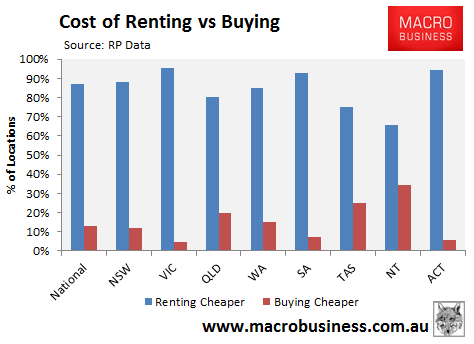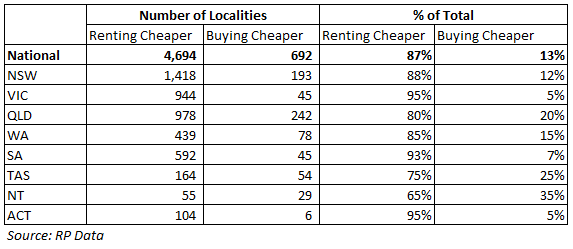
RP Data has released its Buy versus Rent Report for July 2013 (available for download here), which has once again received positive press for the seemingly large increase in the number of locations where it is supposedly cheaper to buy than rent – from 179 suburbs and towns in June 2012 to 692 suburbs and towns in June 2013.
While 692 suburbs and towns sounds like a lot, it actually represents only 13% of locations around Australia where buying a home is supposedly cheaper than renting, according to RP Data’s own figures. A breakdown by state of the results is provided in the below chart and table:


RP Data’s assumptions and methodology are as follows:
- A loan to value ratio (LVR) of 90% which means that the purchaser is borrowing 90% of the value of the home (i.e. they have a 10% deposit).
- A variable mortgage rate of 5.4% per annum.
- The loan period is 30 years.
- The repayment schedule is monthly.
- The principal is calculated based on the suburb’s median house and unit value as at June 2013.
- Rental costs are based on the median weekly advertised rental rate across the suburb over the past 12 months to June 2013.
The analysis also does not consider costs associated with either home ownership or renting which may include but are not limited to:
- Maintenance
- Council rates
- Electricity
- Water and sewerage
- Land tax
- Body corporate levies
- Stamp duty
- Legal and conveyancing fees
As noted last time, RP Data’s methodology is simplistic and skews the results in favour of buying over renting.
In particular, not including the buyer’s assumed 10% deposit in its analysis is questionable given that it represents a significant opportunity cost. For example, a $40,000 deposit on a modest $400,000 home could buy around 90 week’s rent in a typical Melbourne house. It could also earn the buyer around $1,500 a year in interest (pre-tax) if placed in a one-year term deposit account, which could then also be put towards rent or other consumption.
Similar criticisms can be made about not including significant costs like stamp duties, body corporate fees, and other costs associated with home ownership. Although, to be fair to RP Data, its analysis also does not include government incentives and subsidies provided to first home buyers, such as first home buyer grants and stamp duty concessions, which provide benefits to first-time buyers over renters.
Overall, RP Data’s Buy versus Rent Report can best be considered an initial rough guide only. Anyone looking to enter the market needs to do their own research, weigh-up the costs and benefits of buying versus renting, and work out which option works best for them.

